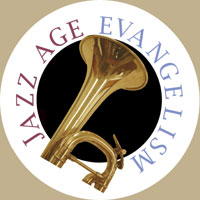

|
Birth of the Tabernacle
|
One
side of a handbill distributed in Chicago announcing Rader's summer campaign.
1922. Click image to see enlargement and reverse side. |
Excerpt (3-3/4 minutes) from tape T1 in Collection 50, oral history interview with Tabernacle musician Merrill Dunlop recorded by Bob Shuster on November 1, 1978.
DUNLOP: In fact, when Paul Rader left Moody Church after seven years as pastor, he was itinerating as an evangelist for a year or so. But a group of people who prized his ministry wanted him to return to Chicago. And (although Paul Rader had planned to go to New York City and build a big tabernacle; in fact, they'd had built the steel structure for it)...and a committee in New York City had gotten together and invited Paul Rader to come and become the pastor of a big evangelis...listic center...evangelistic center in...in New York City. And they had the specifications drawn and the steel was ordered and was...was built for that tabernacle in New York City, which was never built because something happened. And there was some kind of change or disagreement on the part of those men as to the lot and the building and all of that, financing and so forth. And Paul Rader was left with big steel structure.
SHUSTER: What....
DUNLOP: The steel. It wasn't a structure yet.
SHUSTER: But he was the owner, he owned it; he was responsible for it.
DUNLOP: Apparently so. I am not just sure of...of all of those details of ownership. However, Paul Rader then decided to accept the invitation of some of the folks who wanted him to come back to Chicago. And so he found the lot up at the corner of Clark, Barry, and Halsted, which was 3100 north, about two miles north of the Moody Church. And so the steel that had been made for the New York tabernacle fitted that lot and Paul Rader just intended it to be a big summer campaign. So they put it up, they put the steel structure there and they put concrete blocks as the roof over the big structure. And that seated about six thousand people. But it was a huge area. And it was all open, there had no sides. They put...they had big sheets of white canvas that they attached to the sides which kept the...the winds from going through, the cool breezes, you know, and gave protection against rain or weather. And Paul Rader opened that as...as The Big Steel Tent in June...June the 18th, 1922, the opening service. And that was the beginning of the Chicago Gospel Tabernacle. And that big summertime those crowds just came there, just surged throughout that building and filled it up just night after night. And Paul Rader had his big set-up of the tabernacle band and choir. And when the Fall days came along (and he had planned to take the tabernacle down), there was such a hue and cry to keep it going that he decided to brick it in somehow if they could. And Paul Rader did not want to conduct...did not want to have morning services because he felt he did not want to put this tabernacle up in competition to the churches of the area. His idea was a big evangelistic center without membership. And so Sunday school was at two o'clock, Sunday afternoon. And the Sunday afternoon service was at three following the Sunday school. And then he had a cafeteria. People would stay right straight through after the afternoon service was over about five and they could go in there, and get their food. And then the band concert started at six-thirty for a half hour, and during that time people were pouring into the auditorium, you see, to get there for the evening service. And the evening service started at seven....
Leave the exhibit to read the entire interview or the descriptive guide of the Dunlop collection